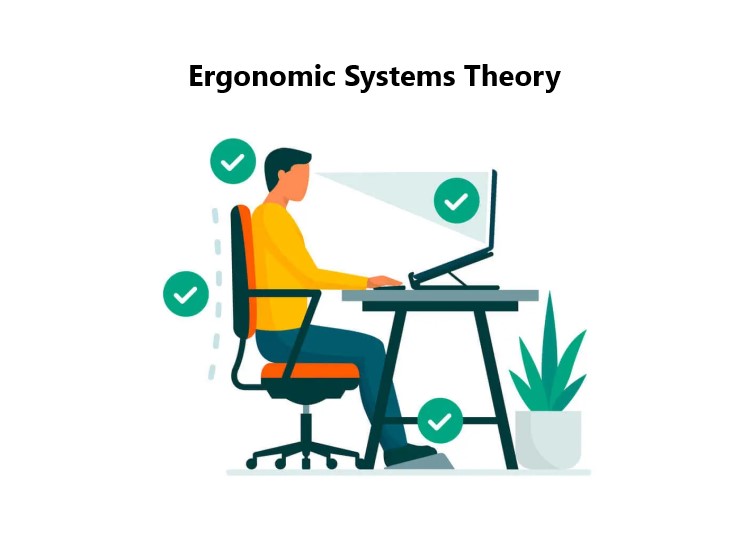
Introduction to Ergonomic Systems Theory: Enhancing Well-being and Productivity
Ergonomic Systems Theory focuses on designing workplace environments that prioritize human well-being and performance. By considering employee comfort and health, this approach aims to create workspaces that reduce physical strain and mental fatigue. Ergonomic Systems Theory not only improves the physical experience of employees but also enhances productivity by supporting a healthier, more focused workforce.
When workplace systems align with ergonomic principles, employees experience fewer aches, injuries, and distractions. This directly impacts productivity, as employees can stay more focused and engaged in their tasks. A well-designed workspace that promotes good posture and reduces strain can also decrease the likelihood of repetitive strain injuries, leading to fewer absences and higher morale.
Implementing ergonomic systems also signals that you value your employees’ well-being, which can boost job satisfaction. With a comfortable and efficient workspace, employees often feel more valued and motivated. This, in turn, can lead to higher levels of productivity, as employees are better equipped to perform at their best. By integrating Ergonomic Systems Theory, you create a work environment that supports both individual health and organizational goals.
The Link Between Ergonomics and Employee Health: Why It Matters
Ergonomic Systems Theory emphasizes the connection between workplace design and employee health. A well-designed, ergonomic workspace promotes physical well-being, helping to reduce strain and fatigue. With proper seating, desk height, and screen placement, employees can maintain better posture, which reduces discomfort in the back, neck, and wrists. Over time, these adjustments can prevent common issues like repetitive strain injuries and musculoskeletal problems.
By minimizing physical discomfort, ergonomic design also reduces workplace injuries, leading to fewer employee absences. When you prioritize ergonomics, you not only lower injury rates but also contribute to a safer, more supportive work environment. Employees are less likely to experience chronic pain and fatigue, which supports their overall wellness. This focus on health creates an atmosphere where employees feel valued and cared for, which can positively impact morale.
Supporting long-term wellness through ergonomic design benefits your organization as well. Healthier employees tend to be more engaged, productive, and satisfied with their work. With Ergonomic Systems Theory, you build a workspace that not only enhances performance but also strengthens your commitment to employee health. In the long run, this investment in ergonomics fosters a positive culture, promoting both well-being and productivity across the organization.
Boosting Organizational Productivity Through Ergonomic Workspaces
Ergonomic Systems Theory highlights how ergonomic adjustments in the workplace can boost productivity by increasing employee comfort and focus. When workspaces are designed to reduce physical strain, employees can maintain their concentration for longer periods without experiencing discomfort. For instance, properly aligned chairs, desks, and screens can reduce neck and back strain, allowing employees to stay engaged and work more efficiently throughout the day.
An ergonomic workspace also supports productivity by reducing fatigue and the risk of injury. When employees work in a comfortable environment, they are less likely to experience repetitive strain or stress-related injuries. Fewer injuries mean fewer absences, which keeps productivity consistent. By minimizing distractions related to physical discomfort, you can create a work setting where employees focus more easily on their tasks and achieve better outcomes.
These ergonomic improvements not only benefit employees but also support organizational goals. Employees who feel physically comfortable tend to experience greater job satisfaction, which can lead to higher retention rates. A well-designed workspace demonstrates your commitment to employee well-being, creating a positive work culture that motivates employees to perform at their best. Ergonomic Systems Theory shows that prioritizing ergonomic adjustments benefits everyone involved, fostering an environment that maximizes both employee satisfaction and organizational productivity.
Designing Workstations for Comfort and Efficiency
Ergonomic Systems Theory offers valuable insights into designing workstations that support both comfort and efficiency. Creating an ergonomic workspace begins with layout, as proper organization helps reduce unnecessary movement and strain. Position frequently used items, like a keyboard, mouse, and phone, within easy reach to minimize stretching. This layout helps employees maintain focus and efficiency without added physical stress.
Choosing the right seating is also essential for comfort. Adjustable chairs that support the lower back allow employees to sit comfortably for longer periods. Look for chairs with adjustable height and armrests, enabling a custom fit for each user. The desk should be at a height where employees can keep their feet flat on the floor, promoting better posture.
Lighting plays a key role in ergonomic design as well. Natural light reduces eye strain, but where it’s limited, adjustable desk lamps help control brightness levels. Using anti-glare screens and proper screen positioning can further reduce eye fatigue, allowing employees to work comfortably. By integrating these ergonomic strategies, you align with Ergonomic Systems Theory, which emphasizes creating work environments that support health and productivity.
Ergonomics in Remote Work: Adapting Home Workspaces
Applying Ergonomic Systems Theory to home offices can help remote employees maintain health and productivity. Designing a comfortable home workspace starts with finding a dedicated area where you can work free from distractions. Select a chair that offers lumbar support and adjustability. When your chair supports your lower back, you’ll reduce the risk of back strain, especially during longer work sessions.
Positioning your screen correctly is also important. Set your monitor at eye level and about an arm’s length away to minimize neck strain. If you work on a laptop, consider using a laptop stand to elevate the screen and add an external keyboard for better typing posture. Proper screen height helps reduce strain on your neck and shoulders, which keeps you comfortable throughout the day.
Lighting plays a key role in maintaining focus and reducing eye strain. Natural light works best, but if it’s limited, add a desk lamp with adjustable brightness. Avoid glare on your screen by positioning it perpendicular to windows, and consider anti-glare screen protectors if needed. By applying these ergonomic principles to your home office, you align with Ergonomic Systems Theory. This approach helps you create a workspace that supports well-being, so you can stay productive and comfortable while working remotely.
Case Studies: Real-World Applications of Ergonomic Systems Theory in the Workplace
Several companies have successfully applied Ergonomic Systems Theory to enhance employee satisfaction, health, and performance. Microsoft, for example, has implemented extensive ergonomic assessments and adjustments across its offices. Employees receive adjustable workstations, ergonomic chairs, and sit-stand desks. By addressing individual comfort needs, Microsoft has seen improvements in employee productivity and reduced musculoskeletal complaints. This focus on ergonomics has also helped foster a culture that values employee well-being, leading to higher job satisfaction.
Google is another company that prioritizes ergonomic principles in its workspace design. Google provides ergonomically adjustable desks, seating, and screen setups that reduce strain and increase comfort. Regular ergonomic training is also available to ensure employees use their workstations correctly. As a result, Google has observed not only a decrease in workplace injuries but also a boost in employee morale. Employees feel supported and valued, which positively impacts both their health and productivity.
At Amazon, ergonomic practices are also applied, particularly in warehouses where physical demands are high. Amazon has invested in ergonomic tools like lift-assist devices and anti-fatigue mats for its employees. These improvements help reduce strain and fatigue, which lowers injury rates and improves job satisfaction. By integrating Ergonomic Systems Theory, these companies create healthier, more supportive workplaces, resulting in a stronger and more productive workforce.
Conclusion
Ergonomic Systems Theory provides valuable insights into creating workspaces that support employee health and productivity. By prioritizing ergonomic design, you promote well-being and reduce workplace injuries. This approach fosters a positive work environment, where employees feel comfortable, valued, and engaged. As companies like Microsoft, Google, and Amazon have shown, applying ergonomic principles can improve employee satisfaction and performance. Investing in ergonomics benefits both employees and the organization, creating a healthier and more efficient workforce. Embracing Ergonomic Systems Theory can help your organization build a sustainable, supportive, and productive workplace.


